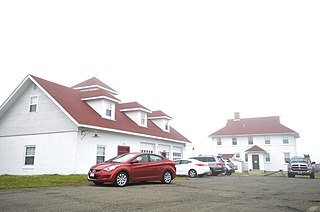 W
WThe Cape Lookout Coast Guard Station is located on the Core Banks of North Carolina between Cape Lookout and the Cape Lookout Light. The station was built as a lifeboat station beginning in 1916 and comprises a complex of several frame buildings. The chief structure is the Main Station, a neo-colonial building with a central cupola or watchtower. It is surrounded by a galley, or messhall, equipment buildings, cisterns and similar support structures. Two similar stations were built at Hatteras Inlet and Cape Fear, which have not survived. The Cape Lookout station was chiefly responsible for providing rescue services in the Cape Lookout Shoals, which extend ten miles into the Atlantic Ocean and represent a significant hazard to coastwise shipping. The Cape Lookout station operated until 1982, and is now under the care of Cape Lookout National Seashore.
 W
WCoast Guard Air Station Salem was a United States Coast Guard air station located in Salem, Massachusetts from 1935 to 1970. Its area of coverage extended from New York City to the Canada–United States border.
 W
WUnited States Coast Guard Station Manomet Point was a United States Life-Saving Service station – and later a United States Coast Guard station – located on Manomet Point in Manomet, Massachusetts. The station was a sub-unit of Sector Southeast New England.
 W
WThe Damariscove Lifesaving Station is a historic coastal maritime rescue facility, located on Damariscove Island in Boothbay, Maine. The station was built in 1897, and is one of the more architecturally distinguished of the surviving stations. It was listed on the National Register of Historic Places on June 25, 1987. It is now privately owned.
 W
WThe Fletcher's Neck Lifesaving Station was a maritime rescue facility at Ocean Avenue and Fourth Street in the Biddeford Pool area of Biddeford, Maine. Established in 1874 by the United States Life-Saving Service, its original building is one of the best-preserved of the first five stations built by the service on the coast of Maine and New Hampshire. A larger station was built adjacent to the original in 1938. The station was in active use until 1971.
 W
WKure Atoll or Ocean Island is an atoll in the Pacific Ocean 48 nautical miles west-northwest of Midway Atoll in the Northwestern Hawaiian Islands at 28°25′N 178°20′W. The only land of significant size is called Green Island and is a habitat for hundreds of thousands of seabirds. A short, unused and unmaintained runway and a portion of one building, both from a former United States Coast Guard LORAN station, are located on the island. Politically, it is part of Hawaii, although separated from the rest of the state by Midway, which is a separate unorganized territory. Green Island, in addition to being the nesting grounds of tens of thousands of seabirds, has recorded several vagrant terrestrial birds including snow bunting, eyebrowed thrush, brambling, olive-backed pipit, black kite, Steller's sea eagle and Chinese sparrowhawk. It is currently managed as a Wildlife Bird Sanctuary by the State of Hawaii's Department of Land and Natural Resource--Division of Forestry and Wildlife as one of the co-trustees of Papahānaumokuākea Marine National Monument with support from Kure Atoll Conservancy.
 W
WSt. George Coast Guard Station, or the Staten Island Coast Guard Station, located adjacent to the Staten Island Ferry St. George Terminal, is a complex of 22 historic buildings and was best known for the invention and manufacturing of lighthouse equipment. The Office Building and U.S. Light-House Depot Complex, designed by Alfred B. Mullet and completed in 1865, are listed on the National Register of Historic Places, and comprise an official New York City Landmark.
 W
WStation Lampang was a United States Coast Guard LORAN facility located in Lampang, Thailand and operated from October 13, 1966 to April 29, 1975. Site preparation work began in April 1966 and most materials were on site by June. By the end of July, the station was manned by the operating crew and first went on the air 8 August 1966. Station Lampang was designated Slave I, with the Master at Sattahip, Thailand, Slave II at Con Son Island Vietnam and the Monitor located at Udorn, Thailand. LORAN Station Tan My, Vietnam was added to the chain in August 1969. The transmitting towers at all locations were 625 feet tall.
 W
WTraining Center Petaluma is a Coast Guard training facility in the northern California counties of Sonoma and Marin. Approximately 4,000 students train there each year. It was formerly the U.S. Army Two Rock Ranch Station.
 W
WWest Quoddy Lifesaving Station is a historic coastal rescue station on West Quoddy Head in Lubec, Maine. The lifesaving station was built in 1919, and was operated by the United States Coast Guard until 1972. It was listed on the National Register of Historic Places on April 20, 1990. It now houses a bed and breakfast inn.
 W
WThe Whitehead Lifesaving Station was a maritime rescue facility on Whitehead Island, an island off the coast of St. George, Maine at the mouth of Penobscot Bay. Established in 1874 by the United States Life-Saving Service, its original building is one of the best-preserved of the five stations built by the service on the coast of Maine and New Hampshire at that time. The station was in active use until the 1940s, and is now privately owned. It was listed on the National Register of Historic Places in 1988.